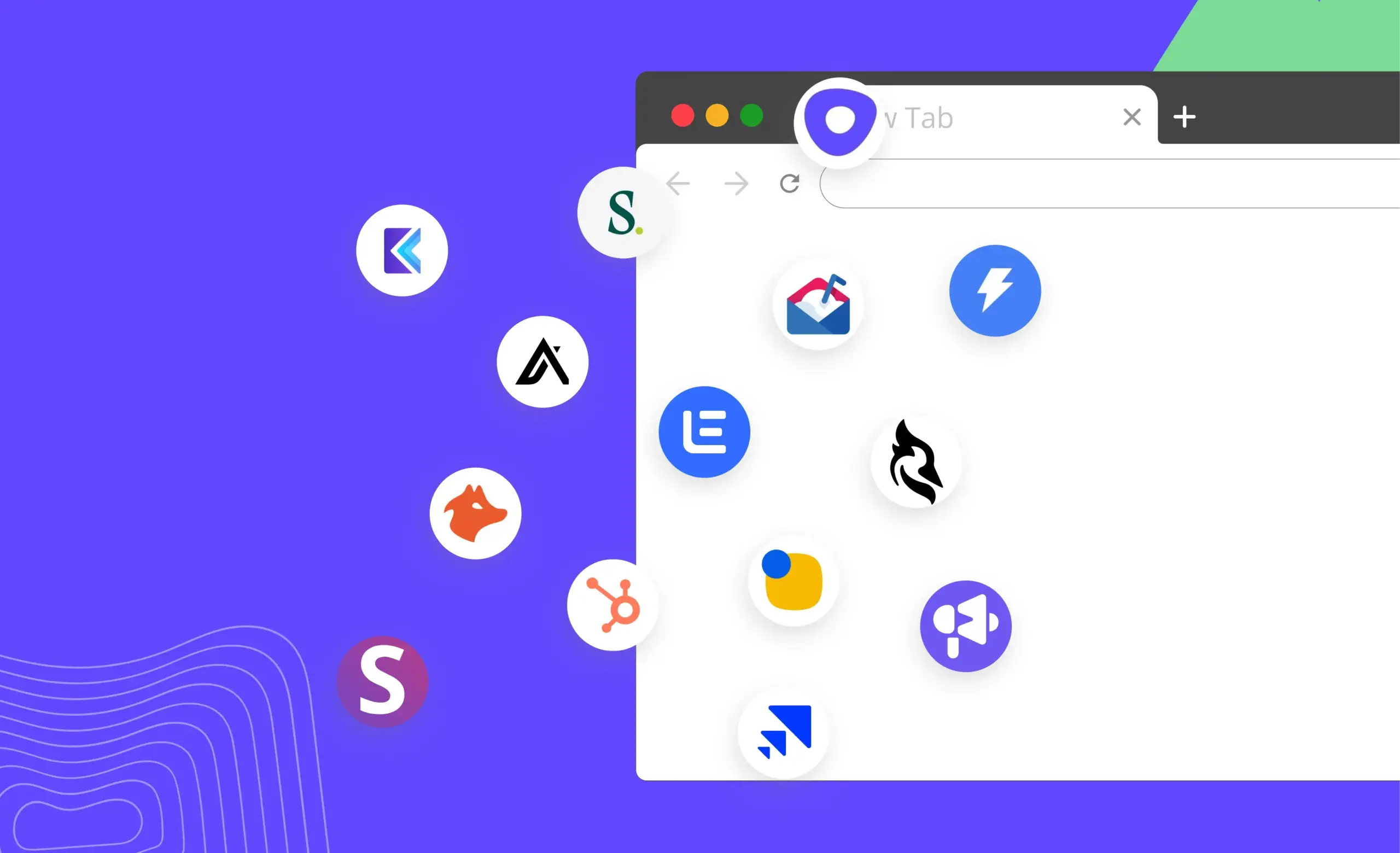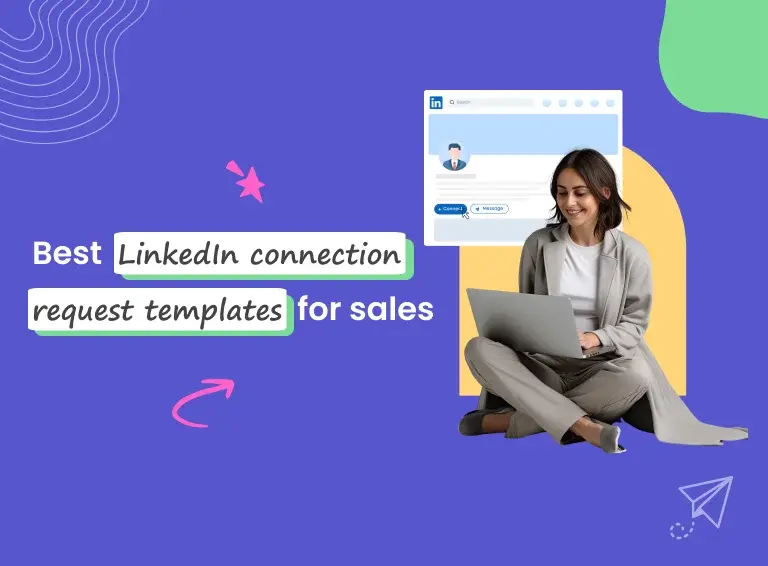“Change is the only constant.”- Greek philosopher Heraclitus.
What he said some 2,500 years ago also rings true for today’s world of sales, which is coming out of a once-in-a-century pandemic, and has a recession on the horizon.
These recent turbulences have significantly impacted buying behaviors. Research by McKinsey and Company found that over 70% of B2B decision-makers prefer remote human interactions or digital self-service.
But, sellers are responding to today's ever-changing sales world by making more calls, more emails, and more pitches. They make the same calls, and send the same emails to everybody, hoping against hope to book a meeting.
But, they find themselves booking fewer and fewer meetings. Their sales cycles become longer and longer as they struggle to close deals.
Why has it come to this? In this arms race as to who sends the most aggressive outreach, many salespeople have become blind to the prospects’ buyer journey.
Some prospects are already looking for a solution. All you need to do is reach out with a personalized message, and you have your meeting. But, there are others who are not so further along in the buying journey. Some experience the problem you solve, but not intensely enough to make them active solution-seekers.
However, most sales reps don’t consider where the buyer is in their journey. This creates a mismatch between what sales teams do and what prospects want at every step. Reps execute the same set of activities for all the prospects, without realizing that prospects only engage with them if the outreach is relevant to them. They keep amping up their outreach efforts, only to see the results dwindle day after day.
Not changing the sales process according to your buyer’s journey is sales rigidity. And its result? Fatigued prospects, frustrated salespeople, and floundering pipelines.
Under this sales rigidity, desperate reps work under fear of not knowing where their next meeting is coming from. They feel exhausted after seeing little to no results for their hard work. No wonder 89% of sales reps feel burned out, according to a Gartner survey.
So, is there a light at the end of this tunnel called sales rigidity? Yes, there is, and it is called sales agility.
What Is Agile Selling?
“Agile” means to have a “quick, resourceful, and adaptable character.” So, agile selling means understanding your buyers and changing your approaches quickly based on their behavior.
To put it another way, the agile approach involves contacting prospects on the right channel, reaching out to them at the right time, and tailoring sequences with the right message.
With agile selling, sales professionals can:
- Meet the prospects where they’re active. Whether it’s email, calls, texts, or LinkedIn—wherever the prospects are active, reps can meet them there.
- Execute the right activities to provide value. By being mindful of the prospect’s buyer journey, salespeople can execute the right set of activities through the right channels. This will convey the product’s potential value to the prospects in every engagement.
- Guide the prospects through each step. Salespeople can guide prospects through each step of the sales process, and help them make an informed decision, all at the prospect’s preferred pace.
Make Your Sales Team Agile With These 5 Steps
1. Have a Flexible Sales Process by Following Buyer’s Journey
For outreach, SDRs usually take a reactive approach: They take the list of prospects, add them to a sales cadence and start the various tasks (emails, calls, etc.) mechanically.
But, no two prospects are the same, as they might be in two different stages of the buyer’s journey. Having a single cadence that resonates with prospects at different stages of intent—whether it’s low, medium, or high—might make your sales process rigid.
To convert rigidity into agility, sales reps must be proactive instead of reactive. The proactive approach has 2 aspects: Gauging the prospect’s intent through their activities, and reaching out to prospects using different channels based on where they are in their buying journey.
- Gauging Prospect’s Intent
Within a cadence, a prospect shows intent by opening emails, replying, clicking links, or accepting LinkedIn requests. For example, a prospect who has opened 8 out of your 9 follow-ups and clicked a couple of links has higher buying intent than someone who has opened only 6 emails and doesn’t reply.
So, based on the activity metrics like opens, clicks, and replies, as well as the frequency of these activities, the SDRs must drive prospects with high buying intent into one cadence, the moderate intent group into a different cadence, and those with shallow intent to the third cadence.
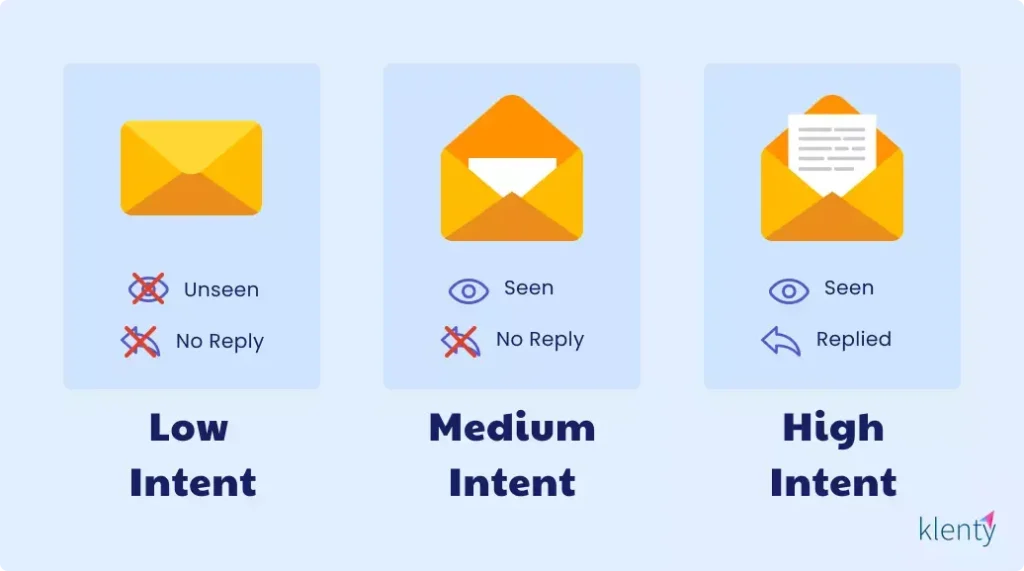
-
- Reaching Out Using Different Channels
Instead of solely depending on one particular channel and carrying out blind follow-ups, sales reps can choose the channel which has the best chance to get a reply based on the buying interest of the prospect, and the channel that prospects prefer to engage with them (some may prefer email, while others may prefer calls or LinkedIn or WhatsApp, etc.).
This way, your sales team can hold the hands of prospects wherever they might be in their buying journey, and direct them to the next step in their respective cadences. Sales agility is all about your sales team executing the right activities and not more activities.
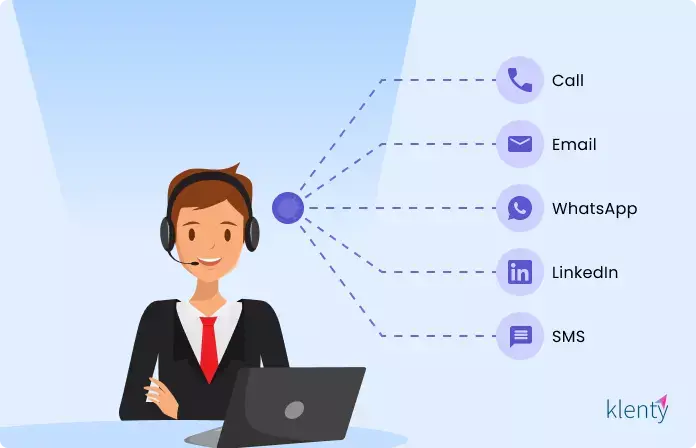
2. Actively Turn Playbooks Into Processes
Sales playbooks tell SDRs the best practices for the different stages of the sales cycle, what the buyer personas are, the possible pain points of prospects, and map out the buyer’s journey.
A tool is only as good as its user. You may have the best sales playbook that’s out there. But if your sales teams are repeating the same steps with scant regard for where the prospect is in their buyer’s journey, your playbook is bound to go outdated, and sales success would elude you.
So, sales teams need to plan, execute, measure, and optimize interactions with prospects according to where they are in the buyer’s journey. This will allow reps to have more meaningful conversations with prospects, and ultimately, help win more deals.
This is what will help you turn playbooks into processes. A sales engagement platform that seamlessly integrates with your CRM will help you track the results better, and make you an agile seller.
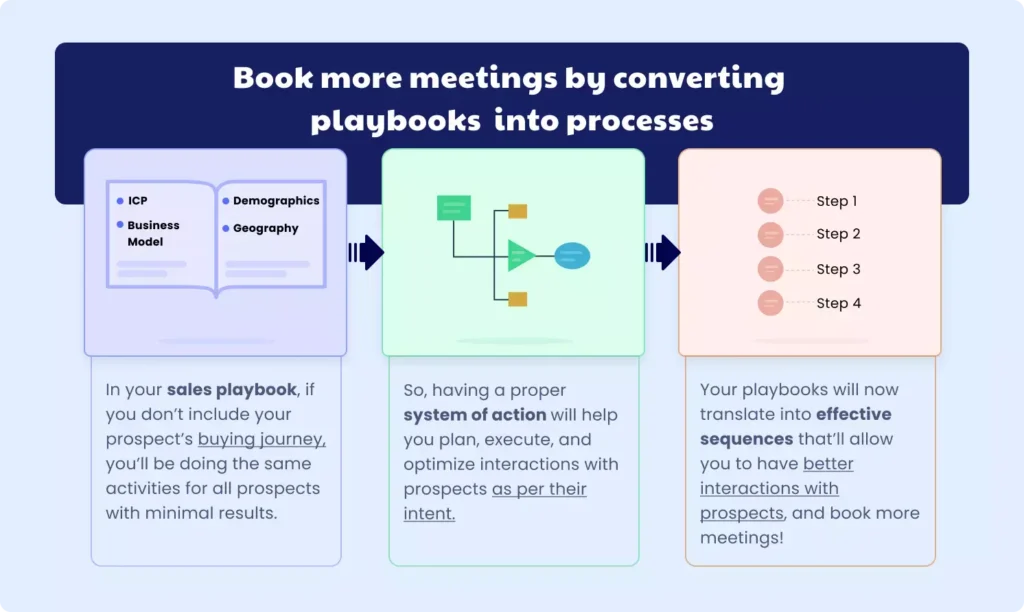
3. Automate Mundane Tasks To Boost Your Rep’s Productivity
Isn’t it absurd that salespeople spend over 66% of their time on activities that don’t generate revenue? Unfortunately, that’s the reality we live in.
With SDRs spending most of their time updating CRMs and on other administrative activities, they hardly have time left to do what they’re supposed to do—selling.
To boost the productivity of reps, automate all their mundane tasks. Use tools that eliminate activities like copy-pasting details from the CRM, schedule pending tasks effectively, allow prospects to automatically book meetings on the rep’s calendars, and allow SDRs to personalize emails at scale.
Using a sales engagement platform will help you simplify your quest to automate and make your reps full-fledged agile sellers. An effective SEP will automate routine tasks, make the CRM workflow hassle-free to do away with manually entering data, and allow personalization across all channels at scale.
4. Encourage Accountability By Setting Clear Goals
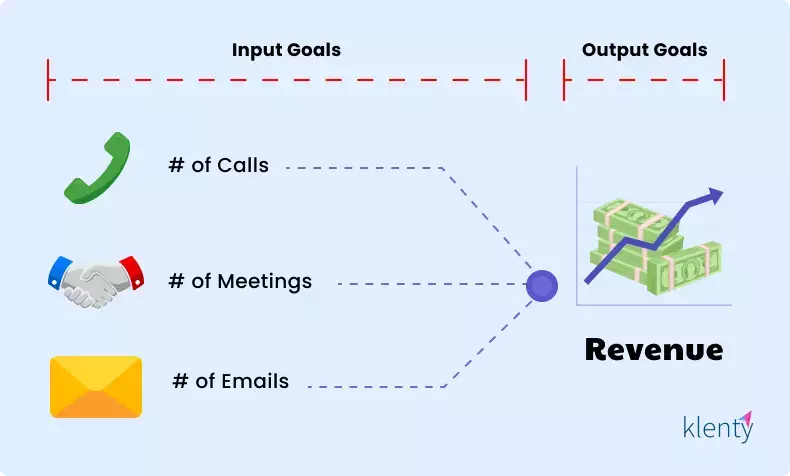
-
For a sales team, fostering a culture of accountability is essential, as it’ll allow every salesperson in the team to take ownership of their tasks and give their best.
Accountability first needs the setting of clear goals for the sales team. This will allow managers to align their expectations with the team and the salespeople can plan their course of action.
There are 2 aspects to goal setting: output goals and input goals. The output goal is the overarching objective for the sales team (like doubling revenue in a year), while the input goals are incremental objectives to be achieved daily, weekly, and monthly (like prospects contacted and meetings booked).
Sales managers need to set the output goal first and plan the input goals to measure the progress towards the goal. Keeping these goals transparent so that each salesperson knows what’s exactly expected of them will help them stay on track.
While planning the input goals, managers need to remember to focus on short-cycle plans, such as daily and weekly goals, rather than solely relying on quotas. Daily and weekly plans create a sense of urgency and keeps the team motivated, while also making it easier to track the progress toward the output goal.
5. Measure and Review Performance
After setting your output and input goals, next comes constant measuring and reviewing of performances.
Break big tasks into sprints for the last 1-2 weeks. The short time frame of these sprints will help the teams focus more and narrow their attention down to specific input goals.
Next, hold daily standups with your team members to take stock of what each salesperson is working on, what they’ve accomplished since the last meeting, and what obstacles they are facing. This would also help in measuring your team’s performance.
This way, the sales manager will have their ears constantly on the ground. Frequent reviews will provide flexibility in your sales strategy, allowing you to quickly adjust your goals and define new metrics.
Top 4 Benefits of Implementing Agile Selling for Your Business
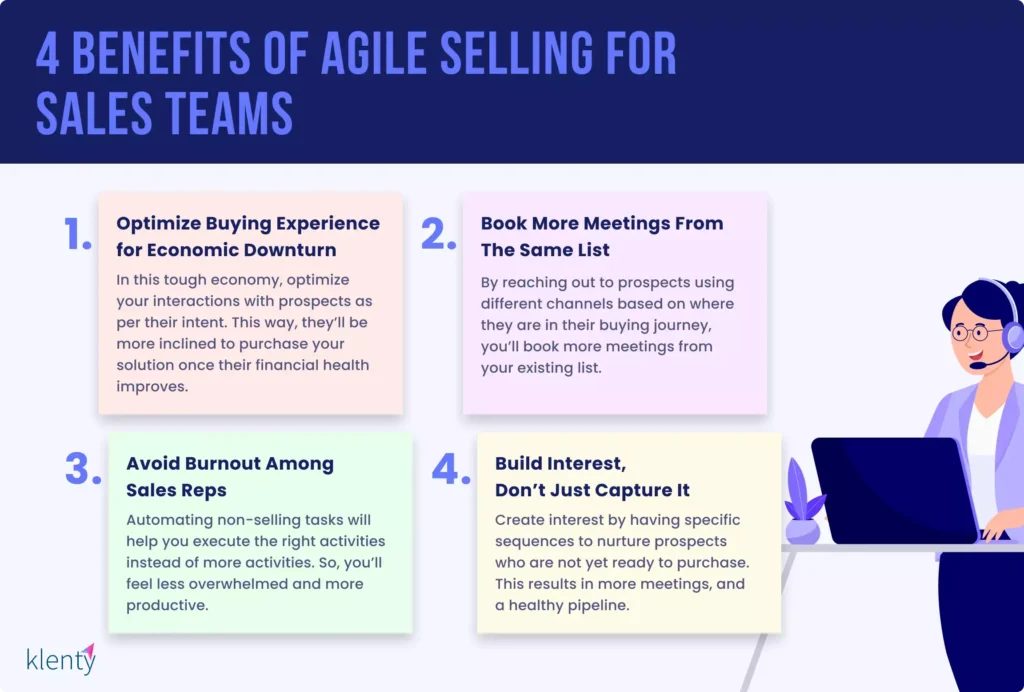
1. Optimize Buying Experience for Economic Downturn
Given the economic downturn and looming recession, sales cycles are bound to get longer and longer. As spending tightens, many buyers will keep finding more reasons to say no to you.
On top of this, if you keep your selling rigid and don’t consider where your prospects are in their journey, the majority of your prospects will simply not engage with you. A study found that digital buying behavior is rapidly changing buying dynamics, and recommended sales organizations to build digital sales experiences that support customer self-learning and buyer’s journey.
By optimizing your interactions as per their intent, you’ll provide your prospects the buying experience they deserve, making them more inclined to consider your products. Even if they’re not able to purchase immediately, you’ll still have a competitive advantage. Once they’re able to loosen their purse strings a little to buy a new product, you’ll be at the top of their mind.
2. Book More Meetings From The Same List
Traditional sales strategies make you upload thousands of prospects to your software, burn through the list with the same outreach tasks, and upload more contacts once you’ve exhausted the list. This is bound to annoy prospects.
Instead, by reaching out using different channels based on where they are in their buying journey, you’ll strike the right balance of being persistent without being annoying.
You’ll book more meetings from the same prospect list instead of adding more names by optimizing your selling according to where the prospects are in their buying journey.
3. Avoid Rep Burnout
Sales reps are in a frenzied race to add more outreach activities and touch for each prospect—more emails, more calls, more texts, and more LinkedIn messages. But, despite executing more activities, they find themselves booking fewer meetings and are unable to hit their quotas. Eventually, they feel exhausted and burned out.
With agile selling comes automating all mundane tasks, so your reps will execute the right activities instead of mindlessly increasing the number of activities. With more time on their hands, they will engage in meaningful conversations with prospects, hold their hands in their buyer’s journey, and hit their quotas.
4. Build Interest, Don’t Just Capture It
So far, SDRs have only been capturing the prospect’s existing interest. They’ve only been focusing on those ready to purchase your product. This sales methodology ignores prospects with low to medium intent, who might only require a little nudge from you to become customers.
Sales reps who are agile sellers can create interest by having specific cadences to nurture those prospects who are not yet ready to purchase. This results in more meetings, and a healthy pipeline.
Final Words
A wise person once said: “Insanity is doing the same thing over and over again and expecting different results.”
This definition is quite apt for sales rigidity too. If your goals are to book more meetings, close more deals, and increase revenue but you do the same activities over and over again without considering the buyer’s intent and behavior, you’re bound to miss the mark.
Hence, by embracing sales agility, you’ll meet prospects on the channels they prefer, reduce friction in the buying process, and help them realize the immediate value of your product. This translates into more meetings booked, more deals closed, and more revenue generated.
In making your selling agile, a robust sales engagement platform like Klenty will help you personalize your outreach according to the channel, and craft your messaging that speaks to your prospect’s specific needs and concerns, wherever they might be in their buying journey.
Rage against the rigidity and become an agile seller now!

